Strategies for a Culturally Safe and Inclusive Learning Environment
VerifiedAdded on 2020/03/07
|11
|2733
|115
Essay
AI Summary
This essay examines the creation of a culturally safe and inclusive learning environment within a diverse classroom setting. The author, a student at a university with a multicultural student body, begins by describing the composition of their learning environment, highlighting the presence of multiple tribes and cultures, and the importance of incorporating these cultures into the learning process. The essay then identifies the diverse cultural needs of the learners, including values, beliefs, language, and practices, with a specific focus on the Muslim culture and gender roles. The author discusses potential barriers to achieving learning outcomes, such as learners' disinterest in other cultures and the influence of foreign cultures on learning processes, including dressing codes. Finally, the essay proposes actions to establish a culturally safe and inclusive learning environment, such as incorporating learner support programs, using various teaching strategies, using a common language, and allowing observation of cultural practices.
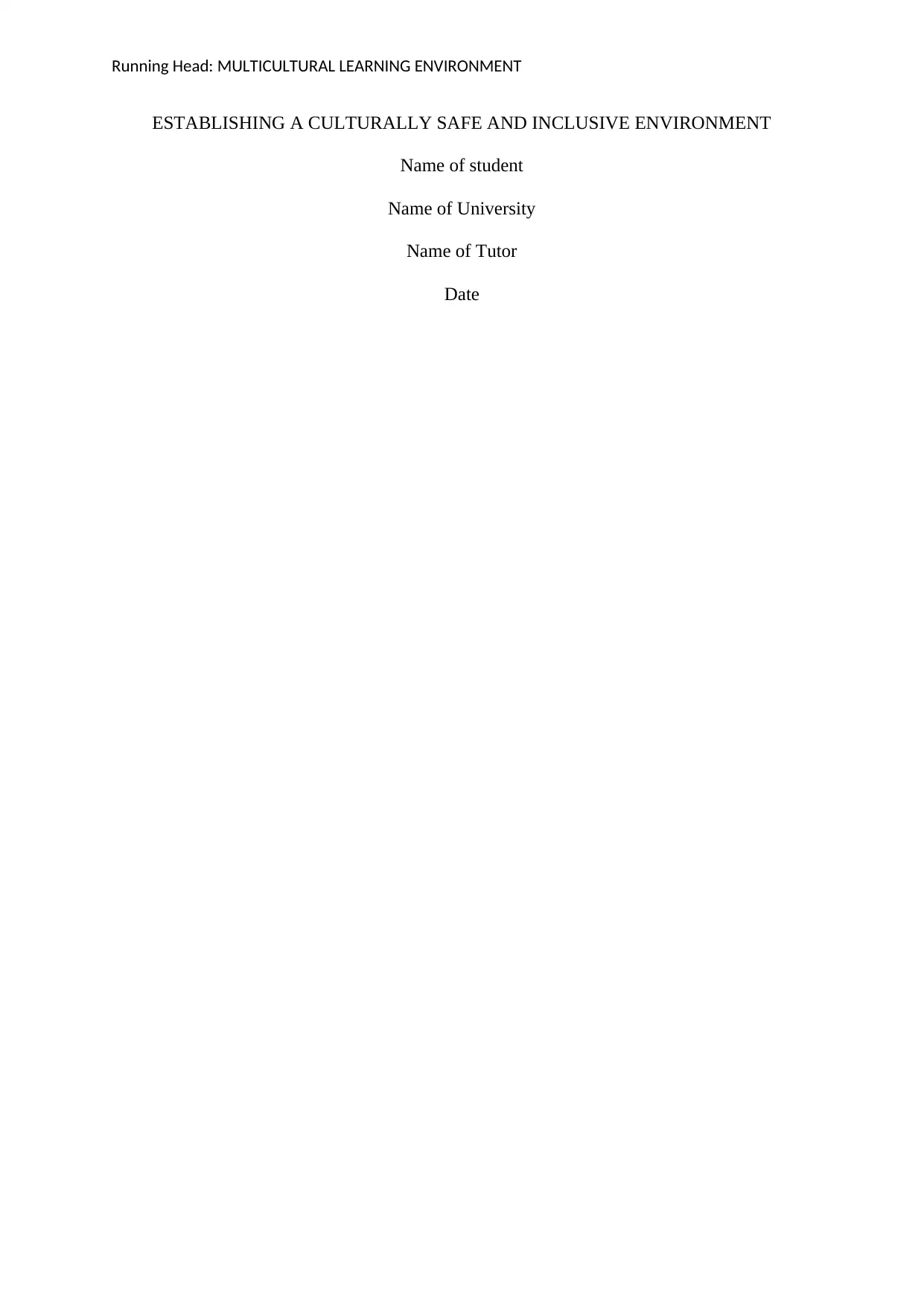
Running Head: MULTICULTURAL LEARNING ENVIRONMENT
ESTABLISHING A CULTURALLY SAFE AND INCLUSIVE ENVIRONMENT
Name of student
Name of University
Name of Tutor
Date
ESTABLISHING A CULTURALLY SAFE AND INCLUSIVE ENVIRONMENT
Name of student
Name of University
Name of Tutor
Date
Paraphrase This Document
Need a fresh take? Get an instant paraphrase of this document with our AI Paraphraser
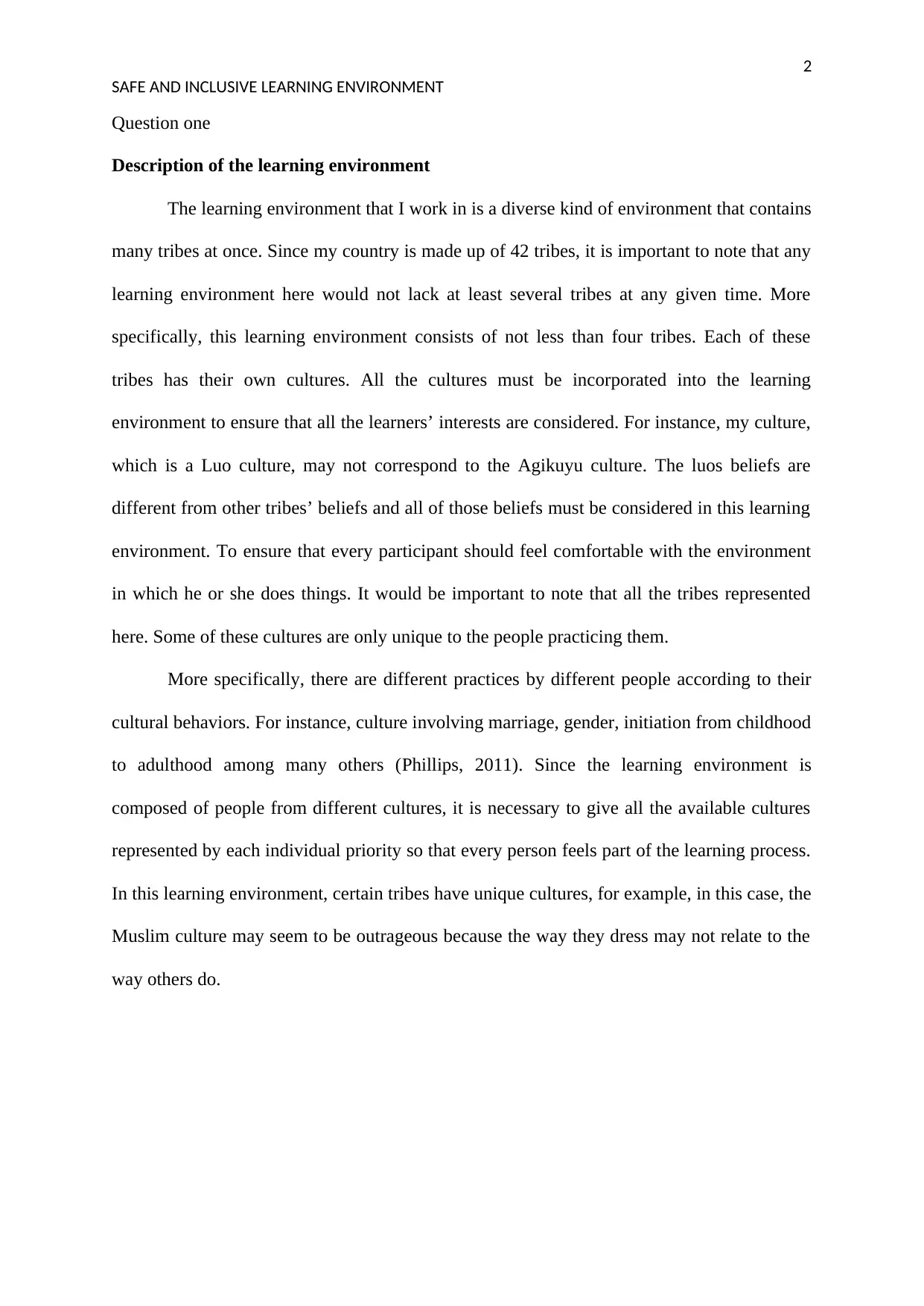
2
SAFE AND INCLUSIVE LEARNING ENVIRONMENT
Question one
Description of the learning environment
The learning environment that I work in is a diverse kind of environment that contains
many tribes at once. Since my country is made up of 42 tribes, it is important to note that any
learning environment here would not lack at least several tribes at any given time. More
specifically, this learning environment consists of not less than four tribes. Each of these
tribes has their own cultures. All the cultures must be incorporated into the learning
environment to ensure that all the learners’ interests are considered. For instance, my culture,
which is a Luo culture, may not correspond to the Agikuyu culture. The luos beliefs are
different from other tribes’ beliefs and all of those beliefs must be considered in this learning
environment. To ensure that every participant should feel comfortable with the environment
in which he or she does things. It would be important to note that all the tribes represented
here. Some of these cultures are only unique to the people practicing them.
More specifically, there are different practices by different people according to their
cultural behaviors. For instance, culture involving marriage, gender, initiation from childhood
to adulthood among many others (Phillips, 2011). Since the learning environment is
composed of people from different cultures, it is necessary to give all the available cultures
represented by each individual priority so that every person feels part of the learning process.
In this learning environment, certain tribes have unique cultures, for example, in this case, the
Muslim culture may seem to be outrageous because the way they dress may not relate to the
way others do.
SAFE AND INCLUSIVE LEARNING ENVIRONMENT
Question one
Description of the learning environment
The learning environment that I work in is a diverse kind of environment that contains
many tribes at once. Since my country is made up of 42 tribes, it is important to note that any
learning environment here would not lack at least several tribes at any given time. More
specifically, this learning environment consists of not less than four tribes. Each of these
tribes has their own cultures. All the cultures must be incorporated into the learning
environment to ensure that all the learners’ interests are considered. For instance, my culture,
which is a Luo culture, may not correspond to the Agikuyu culture. The luos beliefs are
different from other tribes’ beliefs and all of those beliefs must be considered in this learning
environment. To ensure that every participant should feel comfortable with the environment
in which he or she does things. It would be important to note that all the tribes represented
here. Some of these cultures are only unique to the people practicing them.
More specifically, there are different practices by different people according to their
cultural behaviors. For instance, culture involving marriage, gender, initiation from childhood
to adulthood among many others (Phillips, 2011). Since the learning environment is
composed of people from different cultures, it is necessary to give all the available cultures
represented by each individual priority so that every person feels part of the learning process.
In this learning environment, certain tribes have unique cultures, for example, in this case, the
Muslim culture may seem to be outrageous because the way they dress may not relate to the
way others do.
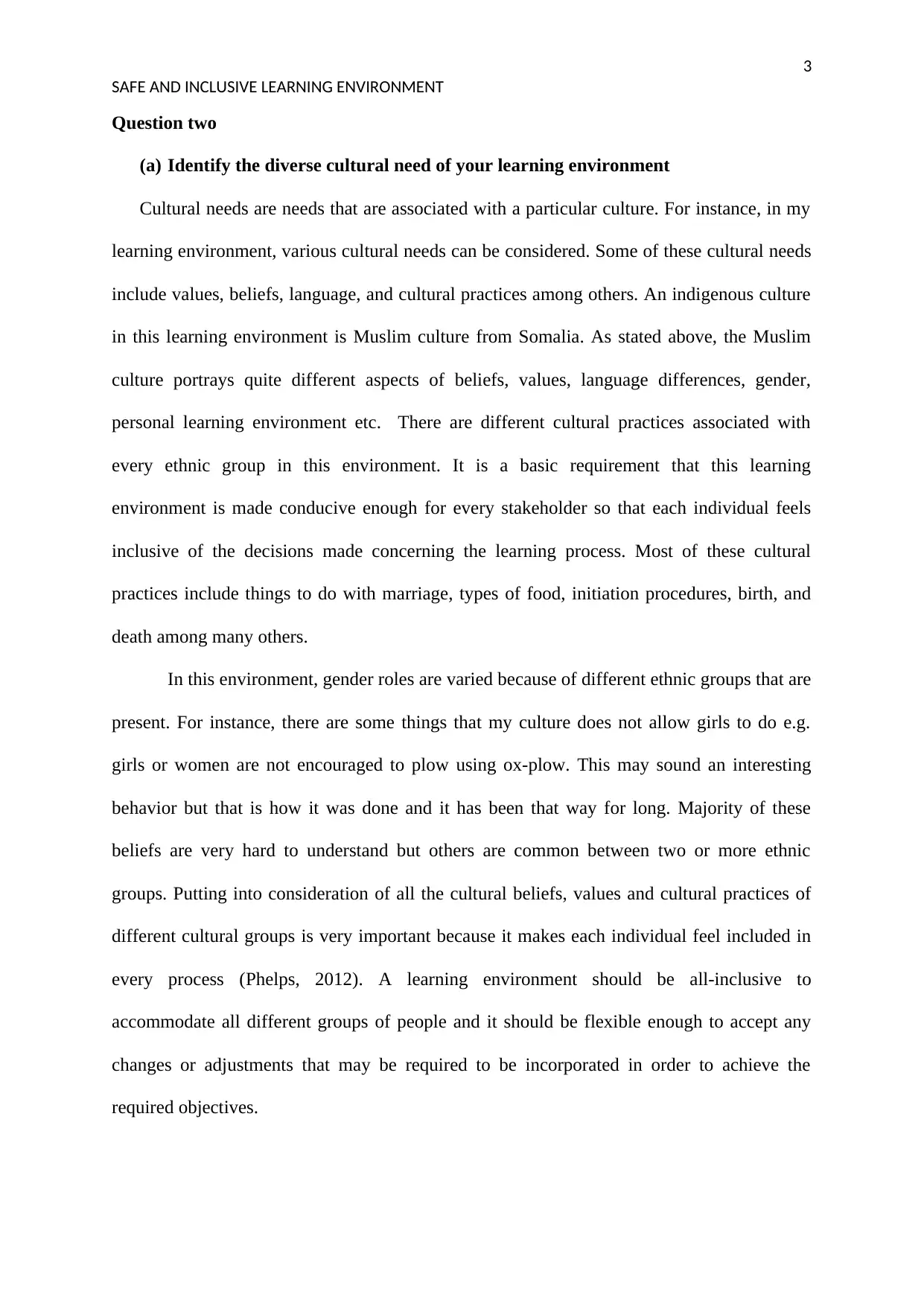
3
SAFE AND INCLUSIVE LEARNING ENVIRONMENT
Question two
(a) Identify the diverse cultural need of your learning environment
Cultural needs are needs that are associated with a particular culture. For instance, in my
learning environment, various cultural needs can be considered. Some of these cultural needs
include values, beliefs, language, and cultural practices among others. An indigenous culture
in this learning environment is Muslim culture from Somalia. As stated above, the Muslim
culture portrays quite different aspects of beliefs, values, language differences, gender,
personal learning environment etc. There are different cultural practices associated with
every ethnic group in this environment. It is a basic requirement that this learning
environment is made conducive enough for every stakeholder so that each individual feels
inclusive of the decisions made concerning the learning process. Most of these cultural
practices include things to do with marriage, types of food, initiation procedures, birth, and
death among many others.
In this environment, gender roles are varied because of different ethnic groups that are
present. For instance, there are some things that my culture does not allow girls to do e.g.
girls or women are not encouraged to plow using ox-plow. This may sound an interesting
behavior but that is how it was done and it has been that way for long. Majority of these
beliefs are very hard to understand but others are common between two or more ethnic
groups. Putting into consideration of all the cultural beliefs, values and cultural practices of
different cultural groups is very important because it makes each individual feel included in
every process (Phelps, 2012). A learning environment should be all-inclusive to
accommodate all different groups of people and it should be flexible enough to accept any
changes or adjustments that may be required to be incorporated in order to achieve the
required objectives.
SAFE AND INCLUSIVE LEARNING ENVIRONMENT
Question two
(a) Identify the diverse cultural need of your learning environment
Cultural needs are needs that are associated with a particular culture. For instance, in my
learning environment, various cultural needs can be considered. Some of these cultural needs
include values, beliefs, language, and cultural practices among others. An indigenous culture
in this learning environment is Muslim culture from Somalia. As stated above, the Muslim
culture portrays quite different aspects of beliefs, values, language differences, gender,
personal learning environment etc. There are different cultural practices associated with
every ethnic group in this environment. It is a basic requirement that this learning
environment is made conducive enough for every stakeholder so that each individual feels
inclusive of the decisions made concerning the learning process. Most of these cultural
practices include things to do with marriage, types of food, initiation procedures, birth, and
death among many others.
In this environment, gender roles are varied because of different ethnic groups that are
present. For instance, there are some things that my culture does not allow girls to do e.g.
girls or women are not encouraged to plow using ox-plow. This may sound an interesting
behavior but that is how it was done and it has been that way for long. Majority of these
beliefs are very hard to understand but others are common between two or more ethnic
groups. Putting into consideration of all the cultural beliefs, values and cultural practices of
different cultural groups is very important because it makes each individual feel included in
every process (Phelps, 2012). A learning environment should be all-inclusive to
accommodate all different groups of people and it should be flexible enough to accept any
changes or adjustments that may be required to be incorporated in order to achieve the
required objectives.
⊘ This is a preview!⊘
Do you want full access?
Subscribe today to unlock all pages.

Trusted by 1+ million students worldwide
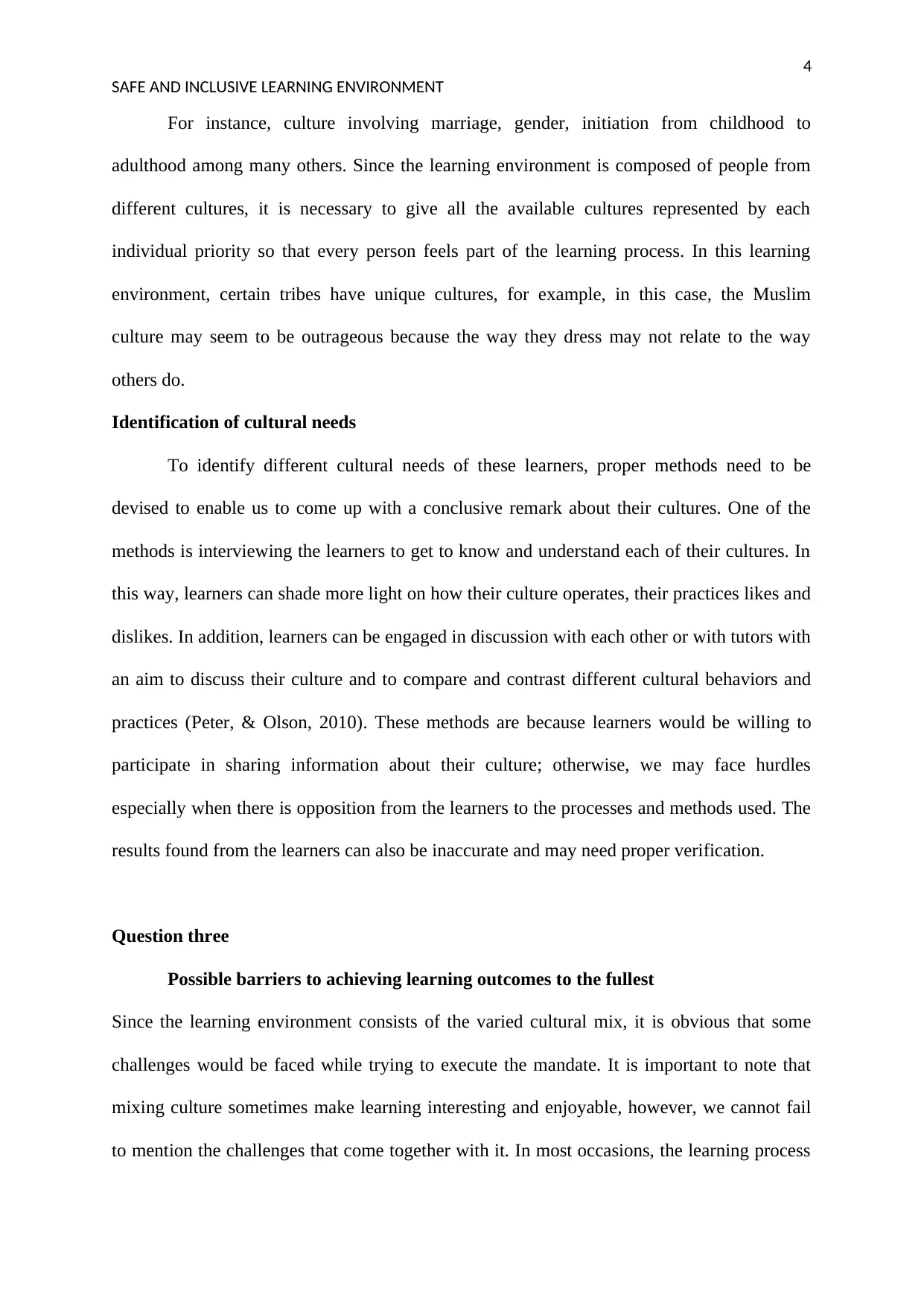
4
SAFE AND INCLUSIVE LEARNING ENVIRONMENT
For instance, culture involving marriage, gender, initiation from childhood to
adulthood among many others. Since the learning environment is composed of people from
different cultures, it is necessary to give all the available cultures represented by each
individual priority so that every person feels part of the learning process. In this learning
environment, certain tribes have unique cultures, for example, in this case, the Muslim
culture may seem to be outrageous because the way they dress may not relate to the way
others do.
Identification of cultural needs
To identify different cultural needs of these learners, proper methods need to be
devised to enable us to come up with a conclusive remark about their cultures. One of the
methods is interviewing the learners to get to know and understand each of their cultures. In
this way, learners can shade more light on how their culture operates, their practices likes and
dislikes. In addition, learners can be engaged in discussion with each other or with tutors with
an aim to discuss their culture and to compare and contrast different cultural behaviors and
practices (Peter, & Olson, 2010). These methods are because learners would be willing to
participate in sharing information about their culture; otherwise, we may face hurdles
especially when there is opposition from the learners to the processes and methods used. The
results found from the learners can also be inaccurate and may need proper verification.
Question three
Possible barriers to achieving learning outcomes to the fullest
Since the learning environment consists of the varied cultural mix, it is obvious that some
challenges would be faced while trying to execute the mandate. It is important to note that
mixing culture sometimes make learning interesting and enjoyable, however, we cannot fail
to mention the challenges that come together with it. In most occasions, the learning process
SAFE AND INCLUSIVE LEARNING ENVIRONMENT
For instance, culture involving marriage, gender, initiation from childhood to
adulthood among many others. Since the learning environment is composed of people from
different cultures, it is necessary to give all the available cultures represented by each
individual priority so that every person feels part of the learning process. In this learning
environment, certain tribes have unique cultures, for example, in this case, the Muslim
culture may seem to be outrageous because the way they dress may not relate to the way
others do.
Identification of cultural needs
To identify different cultural needs of these learners, proper methods need to be
devised to enable us to come up with a conclusive remark about their cultures. One of the
methods is interviewing the learners to get to know and understand each of their cultures. In
this way, learners can shade more light on how their culture operates, their practices likes and
dislikes. In addition, learners can be engaged in discussion with each other or with tutors with
an aim to discuss their culture and to compare and contrast different cultural behaviors and
practices (Peter, & Olson, 2010). These methods are because learners would be willing to
participate in sharing information about their culture; otherwise, we may face hurdles
especially when there is opposition from the learners to the processes and methods used. The
results found from the learners can also be inaccurate and may need proper verification.
Question three
Possible barriers to achieving learning outcomes to the fullest
Since the learning environment consists of the varied cultural mix, it is obvious that some
challenges would be faced while trying to execute the mandate. It is important to note that
mixing culture sometimes make learning interesting and enjoyable, however, we cannot fail
to mention the challenges that come together with it. In most occasions, the learning process
Paraphrase This Document
Need a fresh take? Get an instant paraphrase of this document with our AI Paraphraser
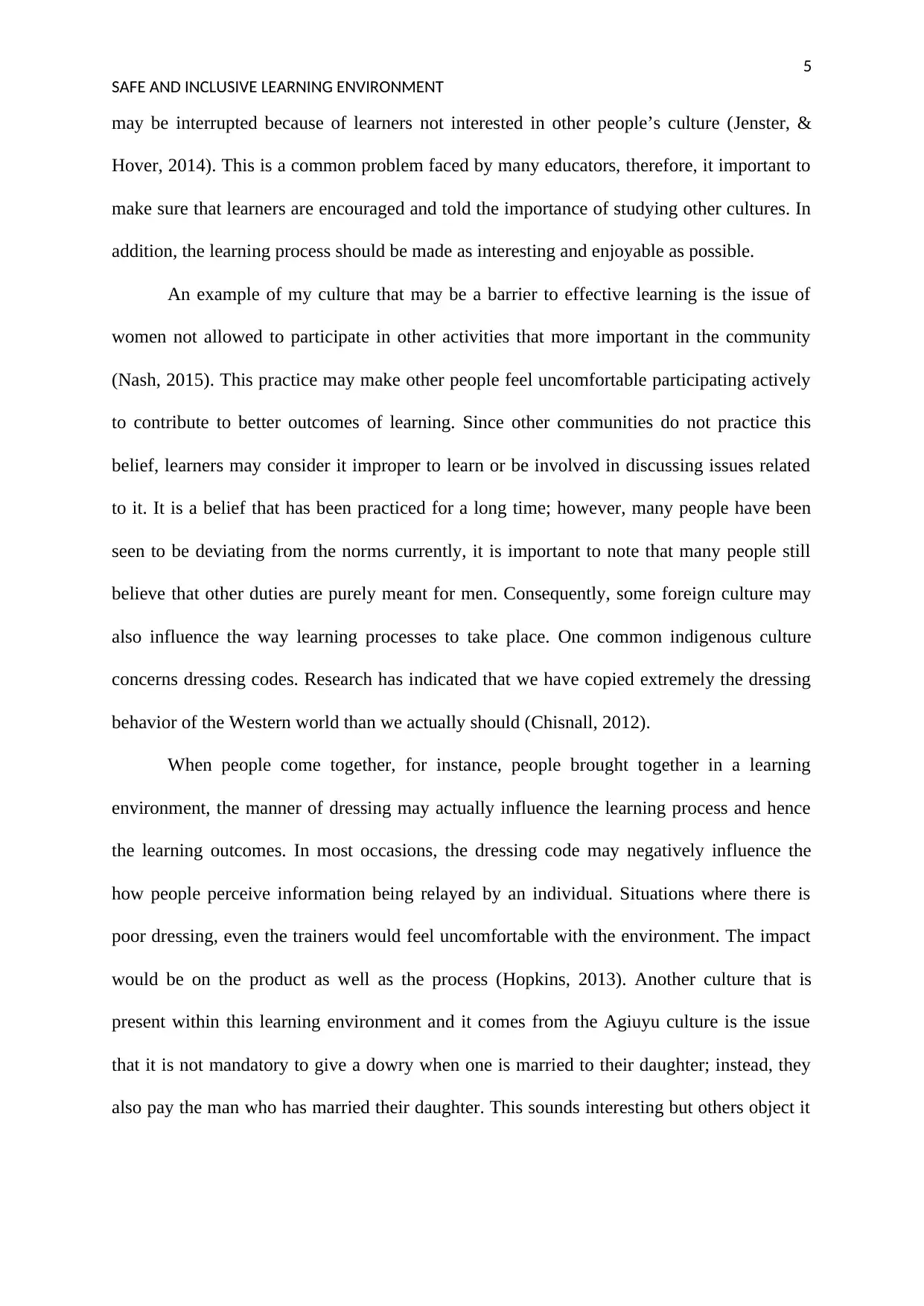
5
SAFE AND INCLUSIVE LEARNING ENVIRONMENT
may be interrupted because of learners not interested in other people’s culture (Jenster, &
Hover, 2014). This is a common problem faced by many educators, therefore, it important to
make sure that learners are encouraged and told the importance of studying other cultures. In
addition, the learning process should be made as interesting and enjoyable as possible.
An example of my culture that may be a barrier to effective learning is the issue of
women not allowed to participate in other activities that more important in the community
(Nash, 2015). This practice may make other people feel uncomfortable participating actively
to contribute to better outcomes of learning. Since other communities do not practice this
belief, learners may consider it improper to learn or be involved in discussing issues related
to it. It is a belief that has been practiced for a long time; however, many people have been
seen to be deviating from the norms currently, it is important to note that many people still
believe that other duties are purely meant for men. Consequently, some foreign culture may
also influence the way learning processes to take place. One common indigenous culture
concerns dressing codes. Research has indicated that we have copied extremely the dressing
behavior of the Western world than we actually should (Chisnall, 2012).
When people come together, for instance, people brought together in a learning
environment, the manner of dressing may actually influence the learning process and hence
the learning outcomes. In most occasions, the dressing code may negatively influence the
how people perceive information being relayed by an individual. Situations where there is
poor dressing, even the trainers would feel uncomfortable with the environment. The impact
would be on the product as well as the process (Hopkins, 2013). Another culture that is
present within this learning environment and it comes from the Agiuyu culture is the issue
that it is not mandatory to give a dowry when one is married to their daughter; instead, they
also pay the man who has married their daughter. This sounds interesting but others object it
SAFE AND INCLUSIVE LEARNING ENVIRONMENT
may be interrupted because of learners not interested in other people’s culture (Jenster, &
Hover, 2014). This is a common problem faced by many educators, therefore, it important to
make sure that learners are encouraged and told the importance of studying other cultures. In
addition, the learning process should be made as interesting and enjoyable as possible.
An example of my culture that may be a barrier to effective learning is the issue of
women not allowed to participate in other activities that more important in the community
(Nash, 2015). This practice may make other people feel uncomfortable participating actively
to contribute to better outcomes of learning. Since other communities do not practice this
belief, learners may consider it improper to learn or be involved in discussing issues related
to it. It is a belief that has been practiced for a long time; however, many people have been
seen to be deviating from the norms currently, it is important to note that many people still
believe that other duties are purely meant for men. Consequently, some foreign culture may
also influence the way learning processes to take place. One common indigenous culture
concerns dressing codes. Research has indicated that we have copied extremely the dressing
behavior of the Western world than we actually should (Chisnall, 2012).
When people come together, for instance, people brought together in a learning
environment, the manner of dressing may actually influence the learning process and hence
the learning outcomes. In most occasions, the dressing code may negatively influence the
how people perceive information being relayed by an individual. Situations where there is
poor dressing, even the trainers would feel uncomfortable with the environment. The impact
would be on the product as well as the process (Hopkins, 2013). Another culture that is
present within this learning environment and it comes from the Agiuyu culture is the issue
that it is not mandatory to give a dowry when one is married to their daughter; instead, they
also pay the man who has married their daughter. This sounds interesting but others object it
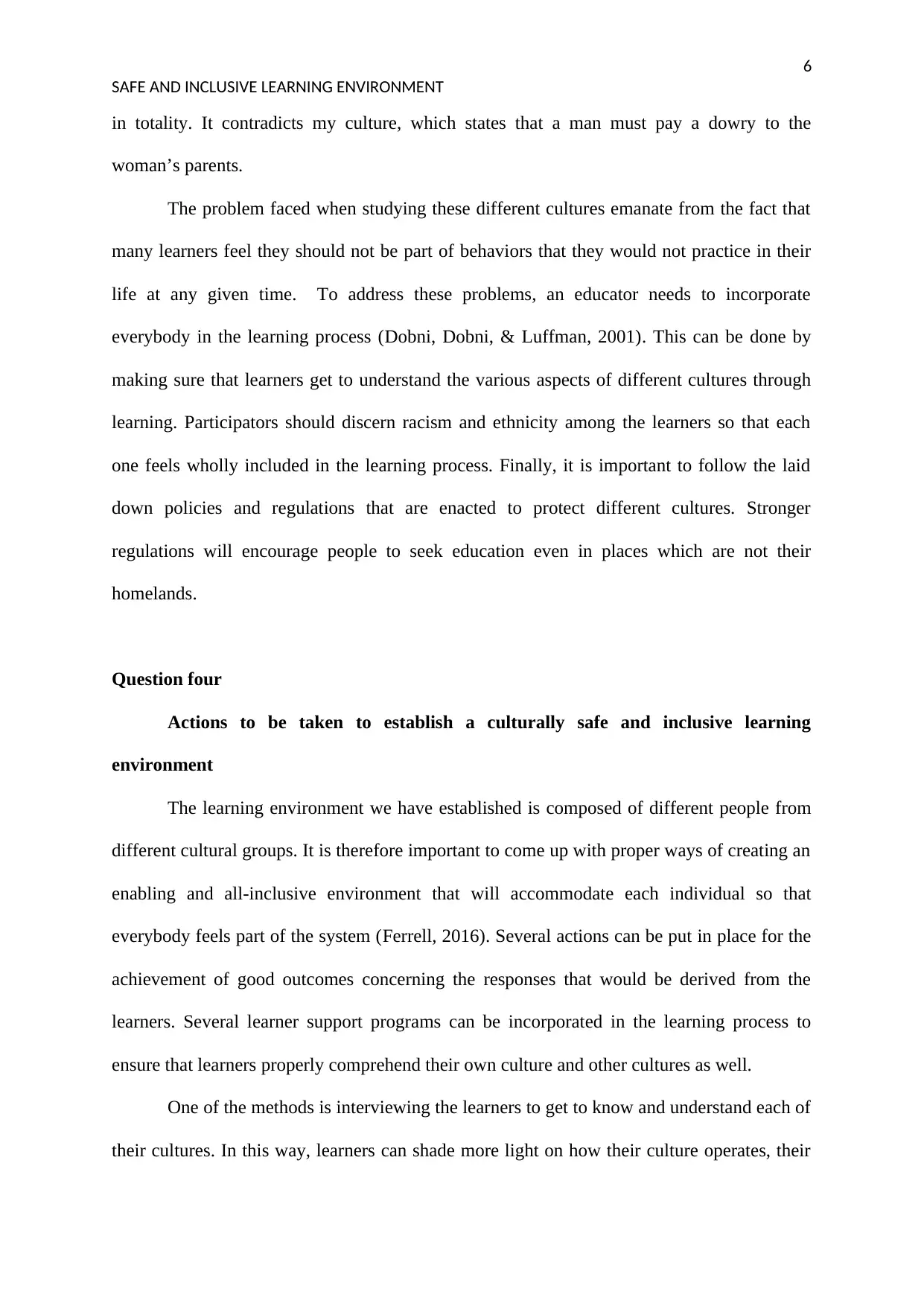
6
SAFE AND INCLUSIVE LEARNING ENVIRONMENT
in totality. It contradicts my culture, which states that a man must pay a dowry to the
woman’s parents.
The problem faced when studying these different cultures emanate from the fact that
many learners feel they should not be part of behaviors that they would not practice in their
life at any given time. To address these problems, an educator needs to incorporate
everybody in the learning process (Dobni, Dobni, & Luffman, 2001). This can be done by
making sure that learners get to understand the various aspects of different cultures through
learning. Participators should discern racism and ethnicity among the learners so that each
one feels wholly included in the learning process. Finally, it is important to follow the laid
down policies and regulations that are enacted to protect different cultures. Stronger
regulations will encourage people to seek education even in places which are not their
homelands.
Question four
Actions to be taken to establish a culturally safe and inclusive learning
environment
The learning environment we have established is composed of different people from
different cultural groups. It is therefore important to come up with proper ways of creating an
enabling and all-inclusive environment that will accommodate each individual so that
everybody feels part of the system (Ferrell, 2016). Several actions can be put in place for the
achievement of good outcomes concerning the responses that would be derived from the
learners. Several learner support programs can be incorporated in the learning process to
ensure that learners properly comprehend their own culture and other cultures as well.
One of the methods is interviewing the learners to get to know and understand each of
their cultures. In this way, learners can shade more light on how their culture operates, their
SAFE AND INCLUSIVE LEARNING ENVIRONMENT
in totality. It contradicts my culture, which states that a man must pay a dowry to the
woman’s parents.
The problem faced when studying these different cultures emanate from the fact that
many learners feel they should not be part of behaviors that they would not practice in their
life at any given time. To address these problems, an educator needs to incorporate
everybody in the learning process (Dobni, Dobni, & Luffman, 2001). This can be done by
making sure that learners get to understand the various aspects of different cultures through
learning. Participators should discern racism and ethnicity among the learners so that each
one feels wholly included in the learning process. Finally, it is important to follow the laid
down policies and regulations that are enacted to protect different cultures. Stronger
regulations will encourage people to seek education even in places which are not their
homelands.
Question four
Actions to be taken to establish a culturally safe and inclusive learning
environment
The learning environment we have established is composed of different people from
different cultural groups. It is therefore important to come up with proper ways of creating an
enabling and all-inclusive environment that will accommodate each individual so that
everybody feels part of the system (Ferrell, 2016). Several actions can be put in place for the
achievement of good outcomes concerning the responses that would be derived from the
learners. Several learner support programs can be incorporated in the learning process to
ensure that learners properly comprehend their own culture and other cultures as well.
One of the methods is interviewing the learners to get to know and understand each of
their cultures. In this way, learners can shade more light on how their culture operates, their
⊘ This is a preview!⊘
Do you want full access?
Subscribe today to unlock all pages.

Trusted by 1+ million students worldwide
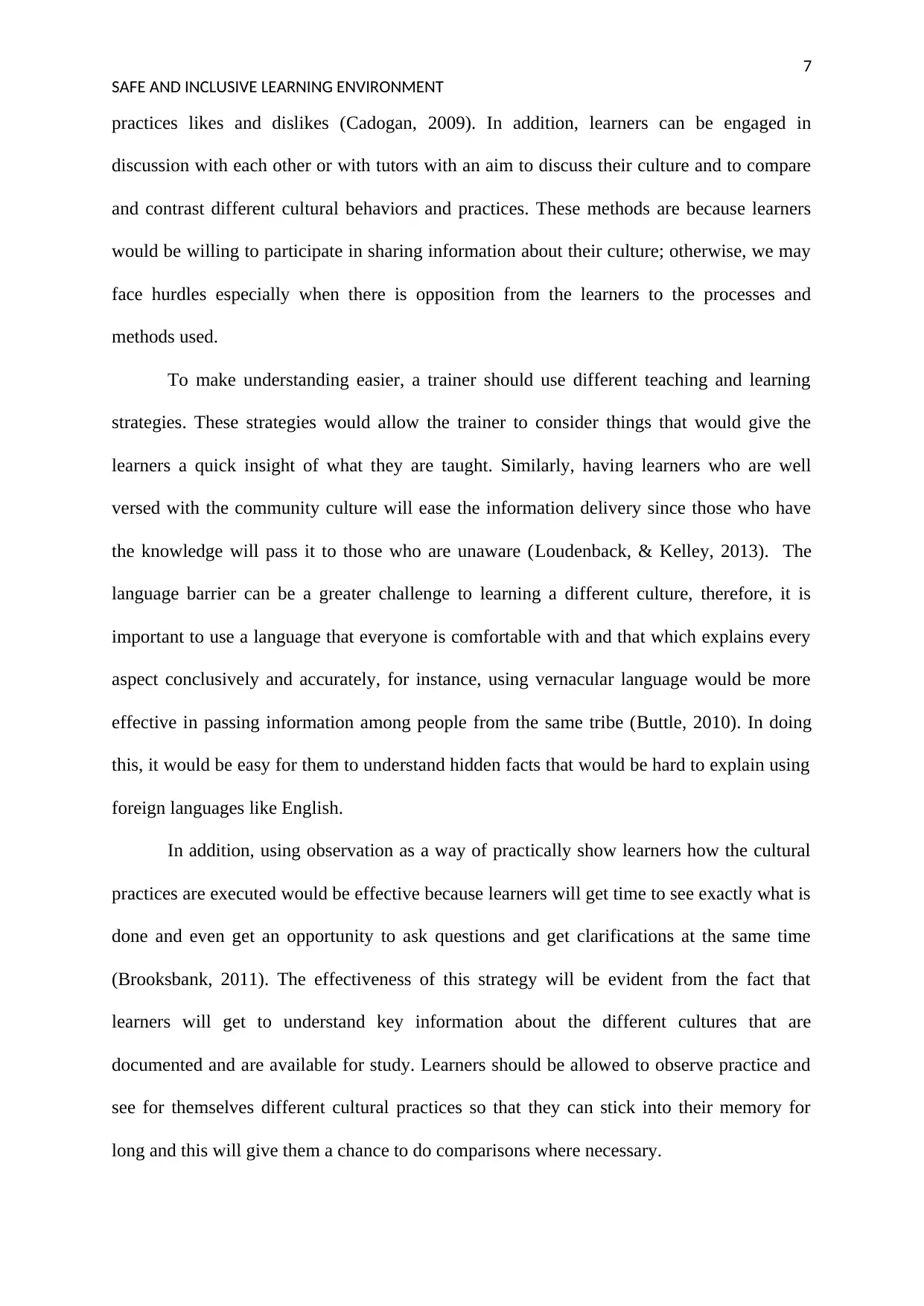
7
SAFE AND INCLUSIVE LEARNING ENVIRONMENT
practices likes and dislikes (Cadogan, 2009). In addition, learners can be engaged in
discussion with each other or with tutors with an aim to discuss their culture and to compare
and contrast different cultural behaviors and practices. These methods are because learners
would be willing to participate in sharing information about their culture; otherwise, we may
face hurdles especially when there is opposition from the learners to the processes and
methods used.
To make understanding easier, a trainer should use different teaching and learning
strategies. These strategies would allow the trainer to consider things that would give the
learners a quick insight of what they are taught. Similarly, having learners who are well
versed with the community culture will ease the information delivery since those who have
the knowledge will pass it to those who are unaware (Loudenback, & Kelley, 2013). The
language barrier can be a greater challenge to learning a different culture, therefore, it is
important to use a language that everyone is comfortable with and that which explains every
aspect conclusively and accurately, for instance, using vernacular language would be more
effective in passing information among people from the same tribe (Buttle, 2010). In doing
this, it would be easy for them to understand hidden facts that would be hard to explain using
foreign languages like English.
In addition, using observation as a way of practically show learners how the cultural
practices are executed would be effective because learners will get time to see exactly what is
done and even get an opportunity to ask questions and get clarifications at the same time
(Brooksbank, 2011). The effectiveness of this strategy will be evident from the fact that
learners will get to understand key information about the different cultures that are
documented and are available for study. Learners should be allowed to observe practice and
see for themselves different cultural practices so that they can stick into their memory for
long and this will give them a chance to do comparisons where necessary.
SAFE AND INCLUSIVE LEARNING ENVIRONMENT
practices likes and dislikes (Cadogan, 2009). In addition, learners can be engaged in
discussion with each other or with tutors with an aim to discuss their culture and to compare
and contrast different cultural behaviors and practices. These methods are because learners
would be willing to participate in sharing information about their culture; otherwise, we may
face hurdles especially when there is opposition from the learners to the processes and
methods used.
To make understanding easier, a trainer should use different teaching and learning
strategies. These strategies would allow the trainer to consider things that would give the
learners a quick insight of what they are taught. Similarly, having learners who are well
versed with the community culture will ease the information delivery since those who have
the knowledge will pass it to those who are unaware (Loudenback, & Kelley, 2013). The
language barrier can be a greater challenge to learning a different culture, therefore, it is
important to use a language that everyone is comfortable with and that which explains every
aspect conclusively and accurately, for instance, using vernacular language would be more
effective in passing information among people from the same tribe (Buttle, 2010). In doing
this, it would be easy for them to understand hidden facts that would be hard to explain using
foreign languages like English.
In addition, using observation as a way of practically show learners how the cultural
practices are executed would be effective because learners will get time to see exactly what is
done and even get an opportunity to ask questions and get clarifications at the same time
(Brooksbank, 2011). The effectiveness of this strategy will be evident from the fact that
learners will get to understand key information about the different cultures that are
documented and are available for study. Learners should be allowed to observe practice and
see for themselves different cultural practices so that they can stick into their memory for
long and this will give them a chance to do comparisons where necessary.
Paraphrase This Document
Need a fresh take? Get an instant paraphrase of this document with our AI Paraphraser
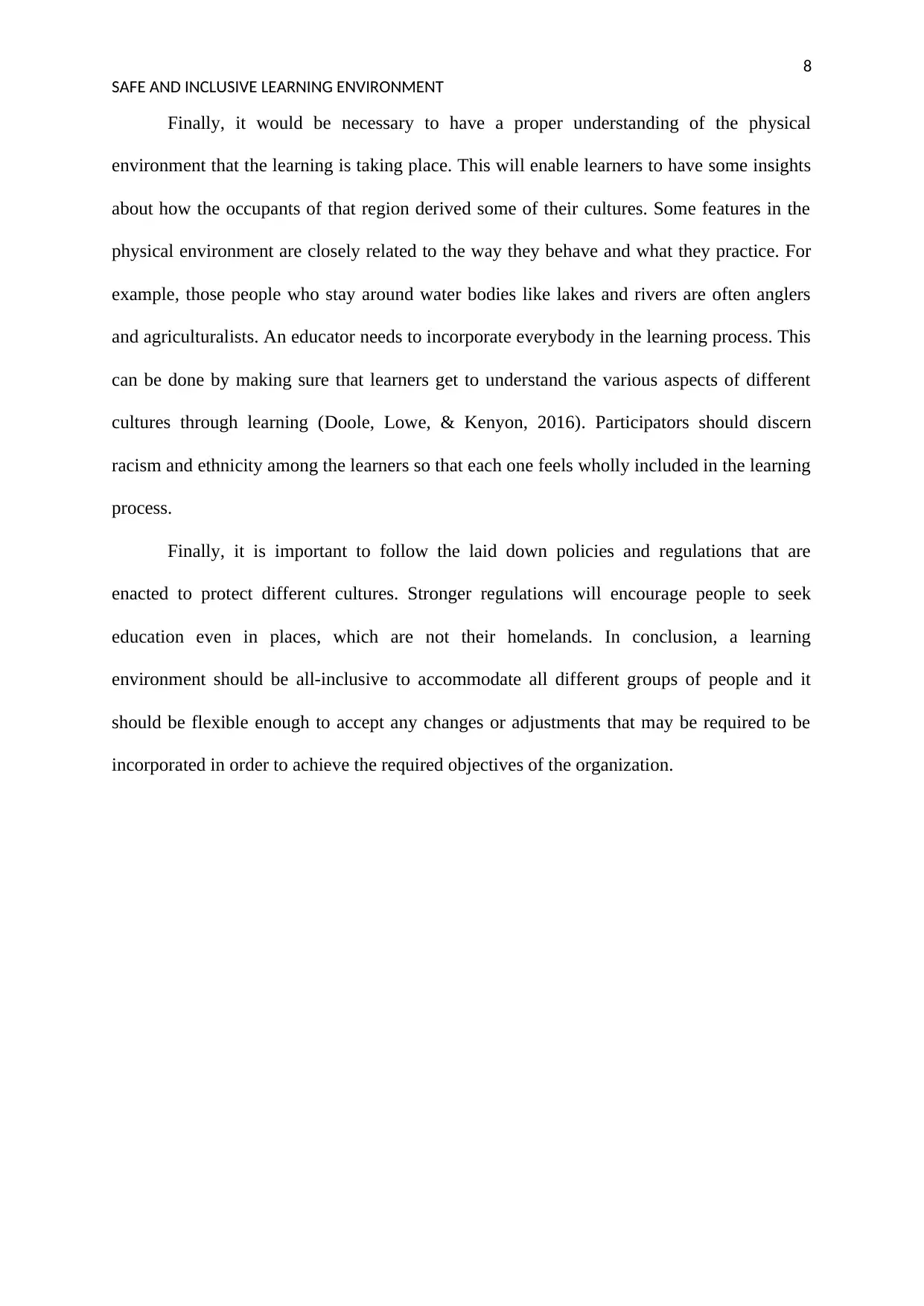
8
SAFE AND INCLUSIVE LEARNING ENVIRONMENT
Finally, it would be necessary to have a proper understanding of the physical
environment that the learning is taking place. This will enable learners to have some insights
about how the occupants of that region derived some of their cultures. Some features in the
physical environment are closely related to the way they behave and what they practice. For
example, those people who stay around water bodies like lakes and rivers are often anglers
and agriculturalists. An educator needs to incorporate everybody in the learning process. This
can be done by making sure that learners get to understand the various aspects of different
cultures through learning (Doole, Lowe, & Kenyon, 2016). Participators should discern
racism and ethnicity among the learners so that each one feels wholly included in the learning
process.
Finally, it is important to follow the laid down policies and regulations that are
enacted to protect different cultures. Stronger regulations will encourage people to seek
education even in places, which are not their homelands. In conclusion, a learning
environment should be all-inclusive to accommodate all different groups of people and it
should be flexible enough to accept any changes or adjustments that may be required to be
incorporated in order to achieve the required objectives of the organization.
SAFE AND INCLUSIVE LEARNING ENVIRONMENT
Finally, it would be necessary to have a proper understanding of the physical
environment that the learning is taking place. This will enable learners to have some insights
about how the occupants of that region derived some of their cultures. Some features in the
physical environment are closely related to the way they behave and what they practice. For
example, those people who stay around water bodies like lakes and rivers are often anglers
and agriculturalists. An educator needs to incorporate everybody in the learning process. This
can be done by making sure that learners get to understand the various aspects of different
cultures through learning (Doole, Lowe, & Kenyon, 2016). Participators should discern
racism and ethnicity among the learners so that each one feels wholly included in the learning
process.
Finally, it is important to follow the laid down policies and regulations that are
enacted to protect different cultures. Stronger regulations will encourage people to seek
education even in places, which are not their homelands. In conclusion, a learning
environment should be all-inclusive to accommodate all different groups of people and it
should be flexible enough to accept any changes or adjustments that may be required to be
incorporated in order to achieve the required objectives of the organization.
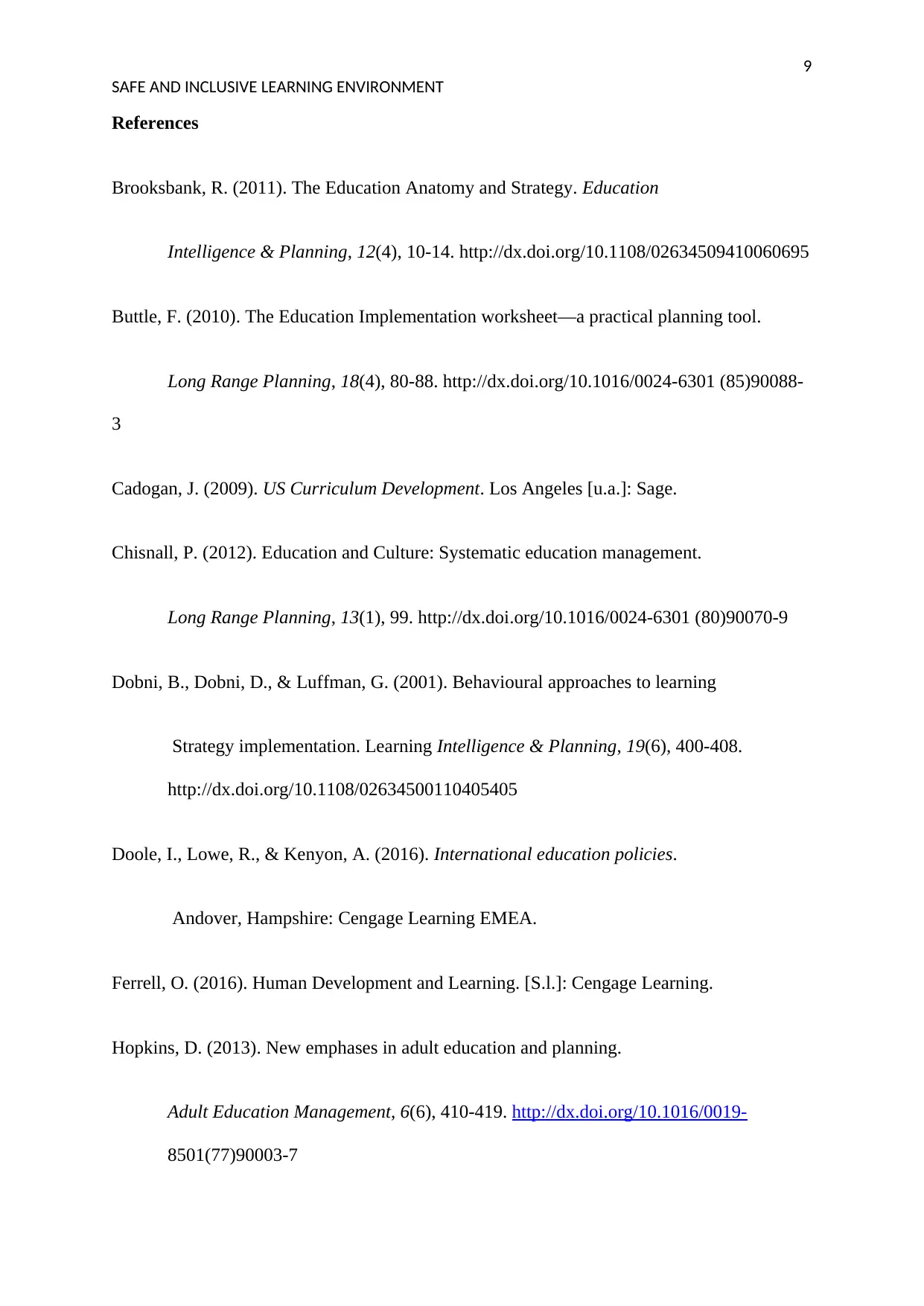
9
SAFE AND INCLUSIVE LEARNING ENVIRONMENT
References
Brooksbank, R. (2011). The Education Anatomy and Strategy. Education
Intelligence & Planning, 12(4), 10-14. http://dx.doi.org/10.1108/02634509410060695
Buttle, F. (2010). The Education Implementation worksheet—a practical planning tool.
Long Range Planning, 18(4), 80-88. http://dx.doi.org/10.1016/0024-6301 (85)90088-
3
Cadogan, J. (2009). US Curriculum Development. Los Angeles [u.a.]: Sage.
Chisnall, P. (2012). Education and Culture: Systematic education management.
Long Range Planning, 13(1), 99. http://dx.doi.org/10.1016/0024-6301 (80)90070-9
Dobni, B., Dobni, D., & Luffman, G. (2001). Behavioural approaches to learning
Strategy implementation. Learning Intelligence & Planning, 19(6), 400-408.
http://dx.doi.org/10.1108/02634500110405405
Doole, I., Lowe, R., & Kenyon, A. (2016). International education policies.
Andover, Hampshire: Cengage Learning EMEA.
Ferrell, O. (2016). Human Development and Learning. [S.l.]: Cengage Learning.
Hopkins, D. (2013). New emphases in adult education and planning.
Adult Education Management, 6(6), 410-419. http://dx.doi.org/10.1016/0019-
8501(77)90003-7
SAFE AND INCLUSIVE LEARNING ENVIRONMENT
References
Brooksbank, R. (2011). The Education Anatomy and Strategy. Education
Intelligence & Planning, 12(4), 10-14. http://dx.doi.org/10.1108/02634509410060695
Buttle, F. (2010). The Education Implementation worksheet—a practical planning tool.
Long Range Planning, 18(4), 80-88. http://dx.doi.org/10.1016/0024-6301 (85)90088-
3
Cadogan, J. (2009). US Curriculum Development. Los Angeles [u.a.]: Sage.
Chisnall, P. (2012). Education and Culture: Systematic education management.
Long Range Planning, 13(1), 99. http://dx.doi.org/10.1016/0024-6301 (80)90070-9
Dobni, B., Dobni, D., & Luffman, G. (2001). Behavioural approaches to learning
Strategy implementation. Learning Intelligence & Planning, 19(6), 400-408.
http://dx.doi.org/10.1108/02634500110405405
Doole, I., Lowe, R., & Kenyon, A. (2016). International education policies.
Andover, Hampshire: Cengage Learning EMEA.
Ferrell, O. (2016). Human Development and Learning. [S.l.]: Cengage Learning.
Hopkins, D. (2013). New emphases in adult education and planning.
Adult Education Management, 6(6), 410-419. http://dx.doi.org/10.1016/0019-
8501(77)90003-7
⊘ This is a preview!⊘
Do you want full access?
Subscribe today to unlock all pages.

Trusted by 1+ million students worldwide
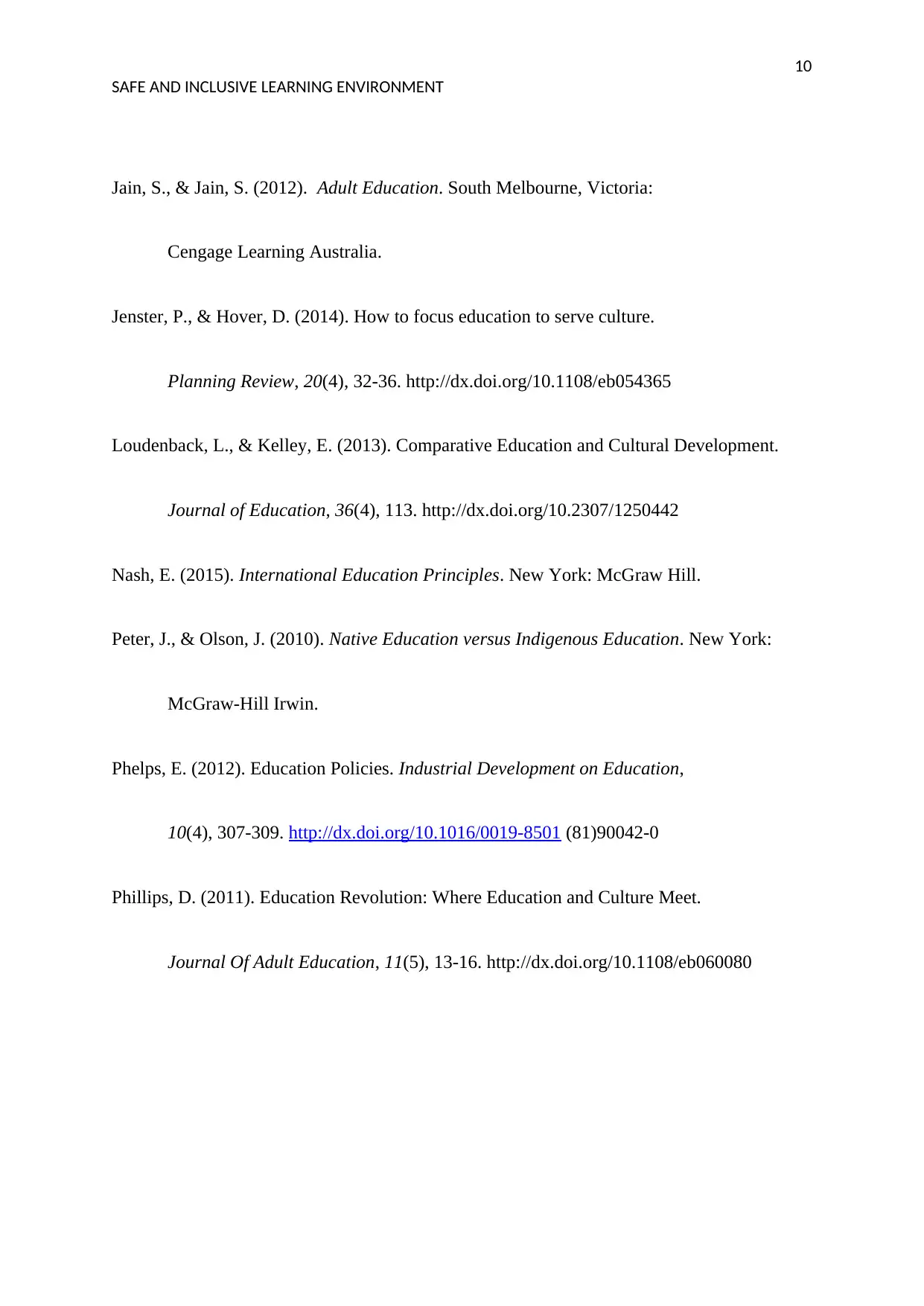
10
SAFE AND INCLUSIVE LEARNING ENVIRONMENT
Jain, S., & Jain, S. (2012). Adult Education. South Melbourne, Victoria:
Cengage Learning Australia.
Jenster, P., & Hover, D. (2014). How to focus education to serve culture.
Planning Review, 20(4), 32-36. http://dx.doi.org/10.1108/eb054365
Loudenback, L., & Kelley, E. (2013). Comparative Education and Cultural Development.
Journal of Education, 36(4), 113. http://dx.doi.org/10.2307/1250442
Nash, E. (2015). International Education Principles. New York: McGraw Hill.
Peter, J., & Olson, J. (2010). Native Education versus Indigenous Education. New York:
McGraw-Hill Irwin.
Phelps, E. (2012). Education Policies. Industrial Development on Education,
10(4), 307-309. http://dx.doi.org/10.1016/0019-8501 (81)90042-0
Phillips, D. (2011). Education Revolution: Where Education and Culture Meet.
Journal Of Adult Education, 11(5), 13-16. http://dx.doi.org/10.1108/eb060080
SAFE AND INCLUSIVE LEARNING ENVIRONMENT
Jain, S., & Jain, S. (2012). Adult Education. South Melbourne, Victoria:
Cengage Learning Australia.
Jenster, P., & Hover, D. (2014). How to focus education to serve culture.
Planning Review, 20(4), 32-36. http://dx.doi.org/10.1108/eb054365
Loudenback, L., & Kelley, E. (2013). Comparative Education and Cultural Development.
Journal of Education, 36(4), 113. http://dx.doi.org/10.2307/1250442
Nash, E. (2015). International Education Principles. New York: McGraw Hill.
Peter, J., & Olson, J. (2010). Native Education versus Indigenous Education. New York:
McGraw-Hill Irwin.
Phelps, E. (2012). Education Policies. Industrial Development on Education,
10(4), 307-309. http://dx.doi.org/10.1016/0019-8501 (81)90042-0
Phillips, D. (2011). Education Revolution: Where Education and Culture Meet.
Journal Of Adult Education, 11(5), 13-16. http://dx.doi.org/10.1108/eb060080
Paraphrase This Document
Need a fresh take? Get an instant paraphrase of this document with our AI Paraphraser

11
SAFE AND INCLUSIVE LEARNING ENVIRONMENT
SAFE AND INCLUSIVE LEARNING ENVIRONMENT
1 out of 11
Related Documents
Your All-in-One AI-Powered Toolkit for Academic Success.
+13062052269
info@desklib.com
Available 24*7 on WhatsApp / Email
![[object Object]](/_next/static/media/star-bottom.7253800d.svg)
Unlock your academic potential
Copyright © 2020–2025 A2Z Services. All Rights Reserved. Developed and managed by ZUCOL.




